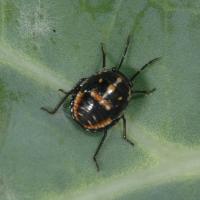Geographical Distribution in Africa
Geographical Distribution of Bagrada bug in Africa (red marked)
The bagrada bug (Bagrada hilaris) is found throughout East and Southern Africa, Egypt, Zaire and Senegal. (Bagrada cruciferarum) has been reported in East and Southern Africa. It is a major cabbage pest in Botswana, Malawi, Zambia and Zimbabwe. Updated on 10 July 2019. Source CABI
General Information on Pest and Damage
Damage
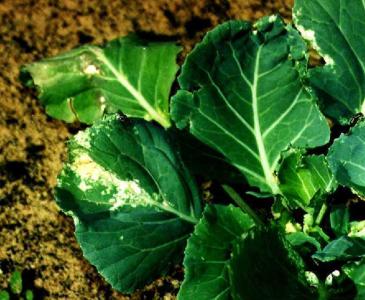 |
| Damage caused by the bagrada bug on cabbage |
|
© B. Loehr, icipe
|
Bagrada bugs damage plants by feeding on young leaves. Both adults and nymphs suck sap from leaves, which may wilt and later dry. Considerable damage is caused to young plants, which may die or have the growth points severely damaged. Significant damage may also be caused to older plants.
Bagrada bugs are major pests of cultivated crucifers. Severe infestations on cabbage result in stunted plants, leaves turning yellow with a rough texture, and death of the growing point. As a result, damaged plants do not produce heads or produce two or more small unmarketable heads instead of a large central head.
Symptoms
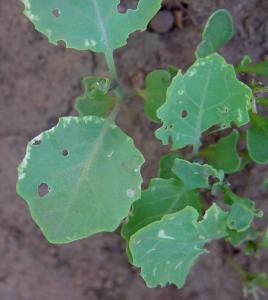 |
| Initial symptoms of damage by bagrada bugs . Note small white punctures on the edges of leaves. |
|
© A. M. Varela, icipe
|
The bugs, especially in the early stages of development, gather in masses and suck the sap from plants. Feeding by the bugs causes small puncture marks visible as white patches starting on the edges of leaves. Eventually the leaves wilt and dry. Heavily attacked plants may have a scorched appearance.
Host range
The bagrada bug is a common stinkbug on cabbage, kale, rape, Chinese cabbage, turnips and other crucifers such as radish. It also attacks potatoes, beetroot, papaya, maize, sorghum and pearl millet, legumes and cotton. It has also been recorded as an occasional pest on groundnuts, wheat, and rooibos tea. The bagrada bug has also been reported as a pest of capper (Capparis spinosa) (Colazza et al. 2004).
Biology and Ecology of the Bagrada Bug
|
Bagrada bug lays its eggs in clusters on leaves or on the soil underneath host plants. Eggs are barrel shaped, initially white and turn orange with age. A single female can lay as many as 100 eggs within 2 to 3 weeks. The incubation period is 5 to 8 days. |
|
Nymphs pass through five stages changing colour from bright orange to red with dark markings, gradually acquiring the colouration of the adult. Initially they do not have wings; wings are gradually developed as the nymphs grow. Wing pads are visible in the last instar nymph. |
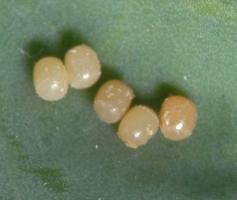 |
| Eggs of the bagrada bug (much enlarged) |
|
© F. Haas, icipe
|
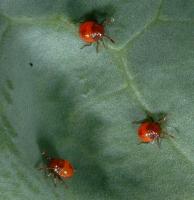 |
| Newly emerged nymphs (first instar) of the bagrada bug. |
|
© F. Haas, icipe
|
|
|
| Third instar nymph of the bagrada bug. |
|
© F. Haas, icipe
|
|
|
| Late instar nymph of the bagrada bug. |
|
© F. Haas, icipe
|
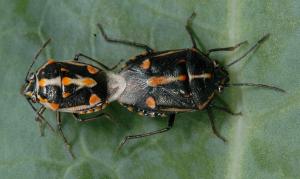 |
| Bagrada bugs The adult bagrada bug (Bagrada hilaris) is 5-7 mm long and 3-4 mm wide. |
|
© F. Haas, icipe
|
The adult bug is typically shield-shaped, 5 to 7 mm long and 3 to 4 mm broad at its widest area. The upper surface has a mixture of black, white and orange markings, which gives the insect its common names harlequin bug or painted bug.
The life cycle lasts 3 to 4 weeks and several generations may occur in a year.
Pest and disease Management
Pest and disease Management: General illustration of the concept of infonet-biovision
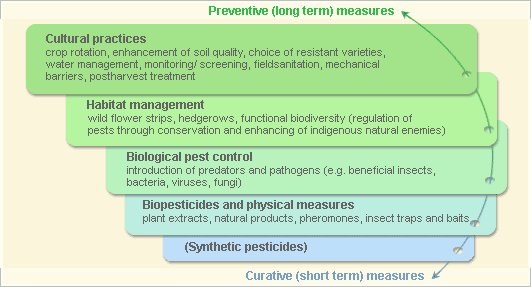

This illustration shows the methods promoted on infonet-biovision. The methods shown at the top have a long-term effect, while methods shown at the bottom have a short-term effect. In organic farming systems, methods with a long-term effect are the basis of crop production and should be of preference. On the other hand methods with a short-term effect should be used in emergencies only. On infonet we do not promote synthetic pesticides.
Further below you find concrete preventive and curative methods against Bagrada bug.
Cultural practices
Monitoring
Regular monitoring of the crop is important to detect bagrada bugs before they cause damage to the crop.
Research in Namibia has shown that control measures should start if the number of bugs/m² in the early growing stage exceeds one. If the crop is past the early growing stage, a higher threshold level of 3 bugs/m² can be maintained (Keizer and Zuurbier). However, note that these thresholds are given as examples. Economic thresholds depend on many factors (crop stage, crop age, and socio-economic and climatic conditions) and cannot be adopted without taking into consideration local conditions.
Sanitation
Crop hygiene, in particular removal of old crops and destruction of weeds of the family Cruciferae prevents population build-up.
Hand picking
Handpicking and destruction of the bugs helps to reduce damage. This is particularly important in the early stages of the crop. Hand picking is only practical in small plots.
Cultivation
Eggs laid in the soil are readily killed by cultivation, so frequent light cultivation (once or twice a week) of the vegetable beds will help in controlling this pest (Keizer and Zuurbier; Horticultural Research Program, Botswana).
Irrigation
Watering and overhead irrigation disturb the bugs discouraging them from feeding on the crop. However, note that use of sprinkler irrigation may lead to increase of diseases such as black rot and downy mildew.
Mixed cropping
Growing strong smelling plants such as garlic, onion or parsley near the crop are reported to reduce infestations (Dobson et al, 2002).
Biological pest control
Natural enemies
Biopesticides and physical methods
Plant extracts
A mixture of chilli, soap, garlic and paraffin has shown to be an effective control method in trials in Namibia (Keizer and Zuurbier).
Natural products
In Namibia there are reports that sprinkling the plants with crushed bagrada bugs repels other bugs. This can be used effectively in combination with frequent soil cultivation (Keizer and Zuurbier).
Soap solution
Spraying plants with a soapy solution (bar soap) has been found effective against bagrada bugs. It helps to wash off young bugs (Dobson et al, 2002; Elwell and Maas, 1995).
Information Source Links
- CAB International (2005). Crop Protection Compendium, 2005 edition. Wallingford, UK www.cabi.org
- CAB International. 1981. Bagrada hilaris (Distribution map). In: Distribution maps of plant pests. Map 417.
- Colazza, S. , Guarino, S., Peri, E. (2004). Bagrada hilaris (Burmeister) (Heteroptera: Pentatomidae) a pest of capper in the island of Pantelleria. J. Informatore Fitopatologico. 54: 30-34.
- EcoPort: The consilience engine. www.ecoport.org
- Elwell, H. and Maas, A. (1995). Natural Pest & Disease Control. Natural Farming network, Zimbabwe. The Plant Protection Improvement Programme and The Natural Farming Network.
- Hill, D. (1983). Agricultural insect pests of the tropics and their control. 2nd edition. Cambridge University Press. ISBN: 0-521-24638-5.
- Varela, A.M., Seif, A. A. and Löhr, B. (2003). A Guide to IPM in Brassicas Production in Eastern and Southern Africa. ICIPE Science Press, Nairobi. ISBN: 92 9064 148 7
- Manual for vegetable production in Botswana. By the Horticultural Research Program. 2003. Published by the Department of Agricultural research. www.dar.gov.bw
- NRI (2002). Integrated Vegetable Pest Management by Hans Dobson, Jerry Cooper, Walter Manyangarirwa, Joshua Karuma and Wilfred Chiimba. Natural Resources Institute, University of Greenwich, UK.
- Keizer, M. and Zuurbier, J. Namibian Crop pests # 22. Bagrada bug.


